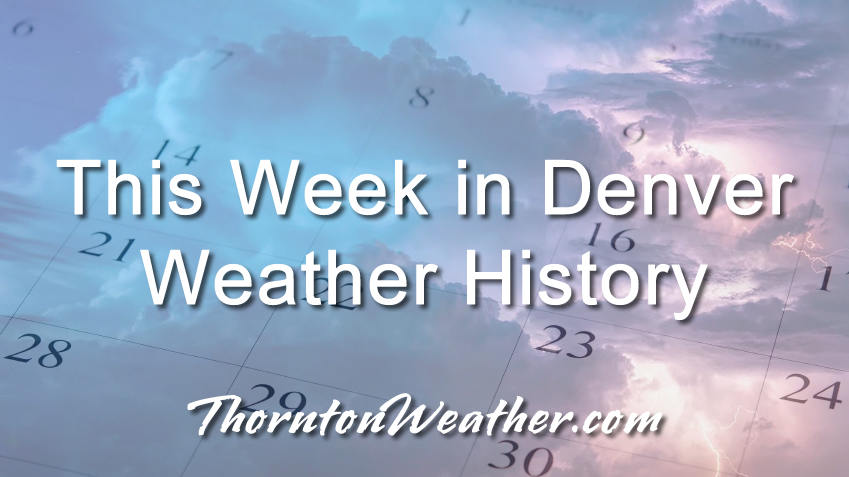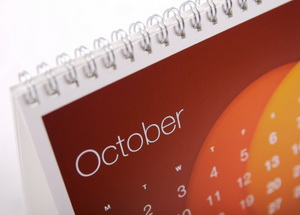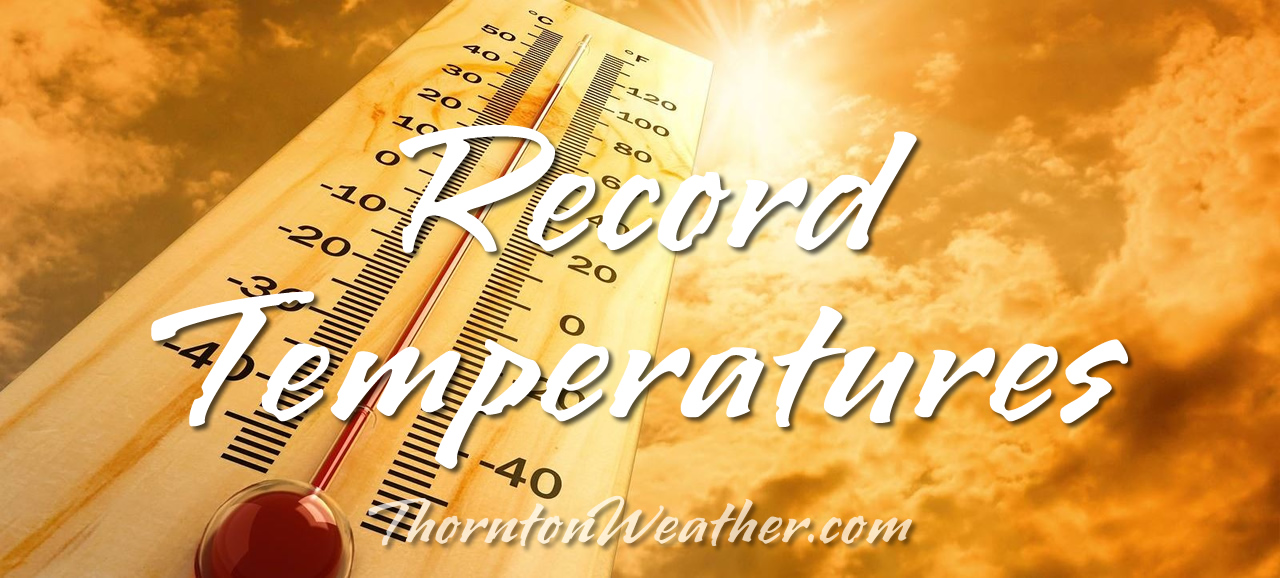
Wind is arguably one of the most annoying weather conditions and as our look back at this week in Denver weather history shows, it is often present this time of year. We also notice some decent shots of snow, including one in 2005 that brought nearly a foot to the Mile High City.
From the National Weather Service:
6
In 1900…northwest winds were sustained to 40 mph with gusts as high as 50 mph in downtown Denver.
In 1903…northwest winds were sustained to 40 mph with gusts to 50 mph. The strong winds warmed the temperature to a high of 71 degrees in the city. The low reading was only 46 degrees.
In 1910…light smoke from forest fires drifted over the city.
In 1976…an arctic cold front brought light snow over the foothills above 6 thousand feet. Traffic was snarled at many locations. Only a trace of snow fell at Stapleton International Airport where rainfall totaled 0.20 inch and northeast winds gusted to 41 mph.
In 1991…the brilliant orange sunset was apparently the result of an extensive volcanic smoke layer in the upper atmosphere.
In 1994…strong west to northwest winds developed in the foothills above 9500 feet. A wind gust to 78 mph was recorded atop squaw mountain west of Denver and to 72 mph at Ward northwest of Boulder. Northwest winds gusted to 35 mph at Stapleton International Airport.
In 2011…strong winds developed in and around the Denver area ahead of an approaching storm system. At the National Wind Technology Center…peak wind gusts ranged from 79 to 92 mph during the early morning hours. Across metro Denver…the strong winds toppled a few trees and damaged patio furniture. The wind caused a few flight delays at Denver International Airport due to a partial ground stoppage of incoming flights. Peak wind reports also included: 66 mph at Cedar Point…63 mph at Denver International Airport…60 mph at Buckley Air Force Base; 59 mph at Highlands Ranch; 58 mph at Deer Trail and Rocky Mountain Metro Airport in Broomfield; 55 mph at Bennett…Centennial Airport and City Park in Denver.
7
In 1903…north winds were sustained to 40 mph with gusts to 48 mph.
In 1917…post-frontal northwest winds were sustained to 45 mph with gusts to 52 mph. Rain was mixed with a trace of snow…the first of the season. Precipitation totaled 0.22 inch and included the occurrence of hail… Even though no thunder was heard.
In 1950…strong winds caused a power outage in Boulder. This was the heaviest windstorm since January. Damage was minor. Northwest winds gusted to only 35 mph at Stapleton Airport.
In 1985…strong Chinook winds buffeted the Front Range foothills. Wind gusts between 60 and 70 mph were reported in Boulder and atop Squaw Mountain west of Denver. Southwest winds gusted to 41 mph at Stapleton International Airport.
7-8
In 1990…the season’s first snow occurred. Snowfall amounts varied from 3 to 7 inches across metro Denver. Snowfall totaled 4.0 inches at Stapleton International Airport where north winds gusted to 29 mph.
8
In 1923…southeast winds were sustained to 44 mph with gusts to 47 mph. The strong winds persisted through the afternoon. The high temperature of 77 degrees was the warmest of the month that year.
In 1975…a wind gust to near 100 mph was recorded in Boulder. Frequent wind gusts to 60 mph were reported along the foothills causing only minor damage. West winds gusted to 45 mph at Stapleton International Airport.
8-9
In 2017…an early season snowstorm produced heavy wet snow which broke branches and downed power lines. About ninety-eight thousand outages occurred in Denver and the surrounding metro area. Almost half the outages were very short…while 54210 were sustained outages that lasted longer than five minutes. Some however lasted for several hours. Snow amounts varied greatly along the Interstate 25 Corridor. West of I-25…storm totals included: 7.5 inches in Arvada…7 inches in Broomfield…6 inches Boulder and Louisville…with 5 inches at Ralston Reservoir. East of I-25…storm totals ranged from a trace to 4 inches. In the mountains and foothills…storm totals included: 12.5 inches near Genesee…10 inches at Eldorado Springs… Idledale and Nederland…with 8.5 inches near Jamestown.
9
In 1910…light smoke from forest fires in the mountains was sighted over the city.
In 1982…northwest winds gusted to 49 mph at Stapleton International Airport.
9-10
In 2005…a major winter storm brought heavy…wet snowfall to the Front Range mountains…eastern foothills…portions of metro Denver…and the palmer divide. Snow accumulations ranged from 8 to 26 inches with drifts from 3 to 4 feet in places. The heaviest snow occurred to the east and southeast of the city…closing most major highways in that area…including I-70 from Denver to Limon. The Red Cross opened four shelters for people who were stranded along I-70 in eastern Colorado. Since many trees had not yet shed their leaves…the storm caused significant tree damage. One woman in Denver was killed when a tree branch… 8 to 10 inches in diameter…snapped under the weight of the heavy…wet snow and struck her as she was shoveling her driveway. Xcel Energy reported power outages to about 35 thousand customers. Several incoming flights were delayed at Denver International Airport. Snow totals included: 16 inches in the foothills near Boulder…12 inches at Genesee and near Golden…22 inches near Watkins…19 inches near Bennett…17 inches southeast of Aurora…14 inches near Parker…13 inches near Castle Rock…12 inches in Centennial… 11 inches in Parker…and 10 inches at Denver International Airport and in Littleton. While many areas of metro Denver received heavy snow…others experienced almost entirely rain. This included west and northwest metro Denver…Boulder…and Longmont. Rainfall amounts were significant as storm totals ranged between 1.50 and 2.50 inches. The steady rainfall triggered 3 rockslides in foothills canyons. Two of the slides occurred on State Highway 119 in Boulder Canyon and the longest slide…7 feet in length…on State Highway 74 in Bear Creek Canyon at Idledale. North winds were sustained to around 23 mph with gusts to 31 mph at Denver International Airport on the 9th. The high temperature of only 34 degrees on the 10th was a record low maximum for the date. The low temperature on both days was 32 degrees.
In 2019…a vigorous winter like storm system brought intense northerly winds and the cold front blasted through the urban corridor. Peak wind gusts from 50 to 60 mph accompanied the front. Some trees in Denver were uprooted by the strong winds. Light rain and drizzle overnight…changed over to the season`s first snow during the predawn hours of the 10th. Bands of moderate to heavy snow brought 2 to 6 inches of snow in the Front Range mountains…foothills and urban corridor. The morning commute was especially hazardous as falling temperatures froze wet roads. Multiple crashes occurred including: I-25 in Denver…I-70 from Denver west to the Eisenhower Tunnel and State Highway 285 towards Fairplay. Over 300 crashes were reported in Denver and Aurora alone. After reaching a maximum temperatures of 83 degrees on the afternoon of the 9th…the temperature plummeted to 13 degrees on the 10th. A temperature change of 70 degrees…the second largest 2-day swing for the month of October in Denver weather history.
Continue reading October 6 to October 12: This Week in Denver Weather History




 With the first full month of fall here, October usually brings one of the quietest weather months in the Denver area with plenty of mild, sunny days and clear, cool nights.
With the first full month of fall here, October usually brings one of the quietest weather months in the Denver area with plenty of mild, sunny days and clear, cool nights.














































